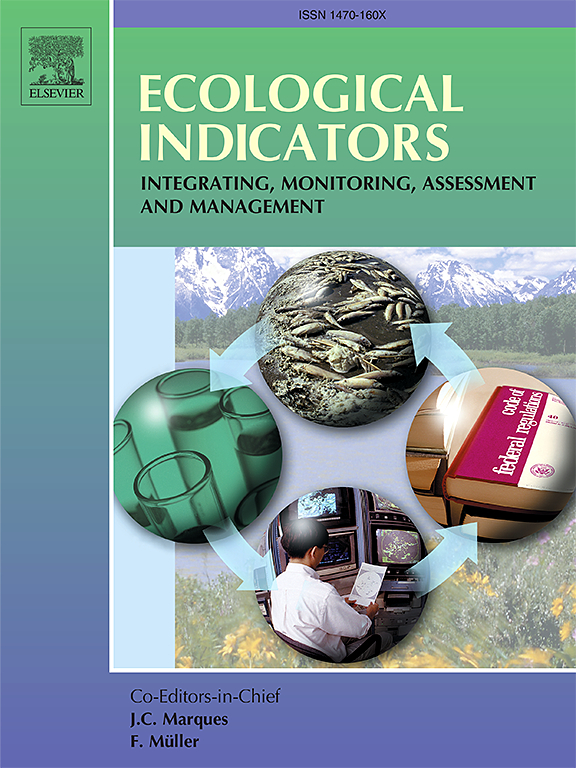Spatial coherence of ecosystem indicators across the Scotian Shelf, Canada
IF 7
2区 环境科学与生态学
Q1 ENVIRONMENTAL SCIENCES
引用次数: 0
Abstract
Marine ecosystems are subject to increasing pressure from climate change and a range of anthropogenic activities such as fishing, aquaculture, tourism, and energy extraction that take place at multiple spatial scales. Understanding the complex interplay between spatially and temporally varying marine ecosystem dynamics is needed for long-term sustainable management. Implementation of ecosystem-based management (EBM) relies in part on ecological indicators that link science to policy while also providing a means to explore ecosystem response to change and to assess progress toward management and policy goals. EBM requires reliable and robust indicators at commensurate spatial scales to assess the ecological impacts of pressures and management actions. We evaluated the spatial and temporal behaviour of ecological indicators at multiple spatial scales to answer three main questions: (i) Is the spatial and temporal resolution of current data collection in the Scotian Shelf fine-grained enough to detect changes in key indicators at the strata level? (ii) How closely do fluctuations in time series at the survey strata level match those at the larger spatial scales? (iii) Is there spatial coherence across survey strata and indicators? We developed a process for examining the reliability and robustness of ecological indicators at differing spatial scales to show that scale does indeed matter.
加拿大苏格兰陆架生态系统指标的空间一致性
海洋生态系统受到气候变化和一系列人类活动(如渔业、水产养殖、旅游业和能源开采)在多个空间尺度上的压力。了解空间和时间变化的海洋生态系统动态之间复杂的相互作用是长期可持续管理的需要。基于生态系统的管理(EBM)的实施部分依赖于将科学与政策联系起来的生态指标,同时也提供了一种探索生态系统对变化的反应和评估管理和政策目标进展的手段。实证医学需要在相应的空间尺度上的可靠和稳健的指标来评估压力和管理行动的生态影响。我们评估了生态指标在多个空间尺度上的时空行为,以回答三个主要问题:(i)目前在斯科舍大陆架收集的数据的时空分辨率是否足够细粒度,以检测地层水平上关键指标的变化?㈡调查地层水平上时间序列的波动与更大空间尺度上的波动有多接近?在各调查层和指标之间是否有空间一致性?我们开发了一个过程来检查不同空间尺度上生态指标的可靠性和稳健性,以表明规模确实很重要。
本文章由计算机程序翻译,如有差异,请以英文原文为准。
求助全文
约1分钟内获得全文
求助全文
来源期刊

Ecological Indicators
环境科学-环境科学
CiteScore
11.80
自引率
8.70%
发文量
1163
审稿时长
78 days
期刊介绍:
The ultimate aim of Ecological Indicators is to integrate the monitoring and assessment of ecological and environmental indicators with management practices. The journal provides a forum for the discussion of the applied scientific development and review of traditional indicator approaches as well as for theoretical, modelling and quantitative applications such as index development. Research into the following areas will be published.
• All aspects of ecological and environmental indicators and indices.
• New indicators, and new approaches and methods for indicator development, testing and use.
• Development and modelling of indices, e.g. application of indicator suites across multiple scales and resources.
• Analysis and research of resource, system- and scale-specific indicators.
• Methods for integration of social and other valuation metrics for the production of scientifically rigorous and politically-relevant assessments using indicator-based monitoring and assessment programs.
• How research indicators can be transformed into direct application for management purposes.
• Broader assessment objectives and methods, e.g. biodiversity, biological integrity, and sustainability, through the use of indicators.
• Resource-specific indicators such as landscape, agroecosystems, forests, wetlands, etc.
 求助内容:
求助内容: 应助结果提醒方式:
应助结果提醒方式:


